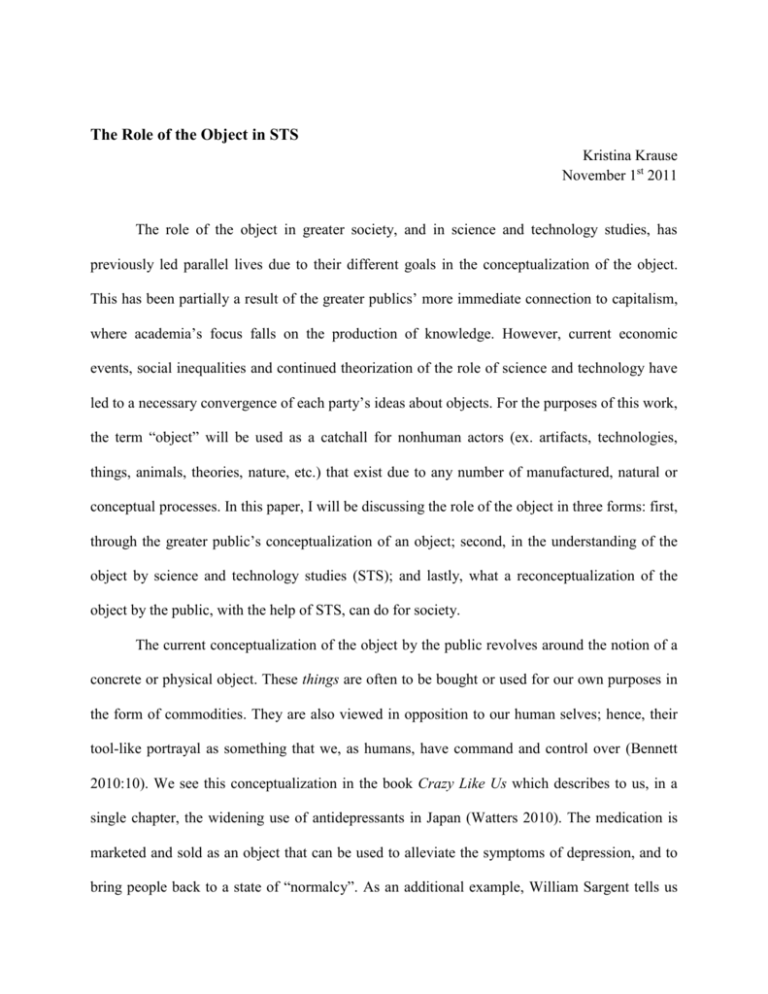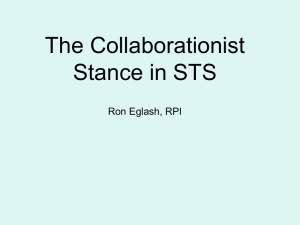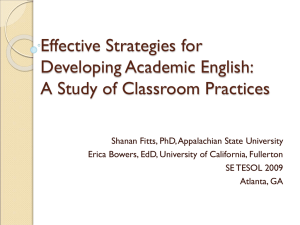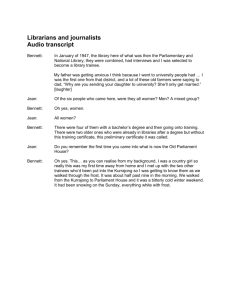The Role of the Object in STS - Kristina Krause – User Researcher
advertisement

The Role of the Object in STS Kristina Krause November 1st 2011 The role of the object in greater society, and in science and technology studies, has previously led parallel lives due to their different goals in the conceptualization of the object. This has been partially a result of the greater publics’ more immediate connection to capitalism, where academia’s focus falls on the production of knowledge. However, current economic events, social inequalities and continued theorization of the role of science and technology have led to a necessary convergence of each party’s ideas about objects. For the purposes of this work, the term “object” will be used as a catchall for nonhuman actors (ex. artifacts, technologies, things, animals, theories, nature, etc.) that exist due to any number of manufactured, natural or conceptual processes. In this paper, I will be discussing the role of the object in three forms: first, through the greater public’s conceptualization of an object; second, in the understanding of the object by science and technology studies (STS); and lastly, what a reconceptualization of the object by the public, with the help of STS, can do for society. The current conceptualization of the object by the public revolves around the notion of a concrete or physical object. These things are often to be bought or used for our own purposes in the form of commodities. They are also viewed in opposition to our human selves; hence, their tool-like portrayal as something that we, as humans, have command and control over (Bennett 2010:10). We see this conceptualization in the book Crazy Like Us which describes to us, in a single chapter, the widening use of antidepressants in Japan (Watters 2010). The medication is marketed and sold as an object that can be used to alleviate the symptoms of depression, and to bring people back to a state of “normalcy”. As an additional example, William Sargent tells us Kristina Krause the story of the horseshoe crab. The horseshoe crab, once viewed purely as an animal, is now a scientific object used in the testing for bacteria, as required by the FDA (2002). More currently, the release in India of a government subsidized tablet (priced at $35 dollars) has been paired with claims that access to this technological object will bridge the digital divide and allow more people in India to reach higher levels of success. As Kapil Sibal, the minister of the country's HRD educational department stated before distributing 650 of the tablets to the students, "To every child in India I carry this message. Aim for the sky and beyond. There is nothing holding you back." This was both a pun, as the name of the tablet is Aakash, or "sky" in Hindi, and a statement of what the technological object would do for them (NPR 2011). Again, what these brief examples showcase is the publics’ idea of an object as something concrete, which can be used to address a specific issue or situation. While the public attaches power to these objects; power to enact change, there appears to be a lack of explicit recognition of the relations that give the object its power. For those praising the tablet as an object of empowerment and change, a conversation relating to the educational system, wireless infrastructure and durability of the devices is also desired, as these variables will have a large impact on the intended purpose of the object. It is here where STS can step in for its own conceptualization of the object. Building on the definition of the object as stated above, STS further defines objects through their history, and the relations that have, or will, construct its existence. While not an STS texts, the book Crazy Like Us provides excellent examples of objects being opened up for others to see their history and details of creation. If we take the example of depression medication in Crazy Like Us, the STS perspective would find that depression medication has an effect on Japanese people, not wholly because of the chemical components, but because pharmaceutical companies have 2 Kristina Krause marketed the idea of depression in a specific manner. “One culture can reshape how a population in another culture categorizes a given set of symptoms, replace their explanatory model, and redraw the line demarcating normal behaviors and internal states from those considered pathological” (Watters 2010: 197). Thus the object as seen by STS is something that functions in the context of Japan because “western” pharmaceutical companies have redefined mental health through their own funded scientific research and marketing, in a manner that allows for expanded use and diagnosis of depression in Japan. More simply, pharmaceuticals have worked to build the context necessary for depression medication to succeed. In the same way, it is unsure whether or not India can build the infrastructure necessary for its tablet to succeed. Beyond making explicit what objects are “made of”, STS provides the object with agency. Objects compel other objects and humans to act, to create meaning, to enact change, to become other objects. Jane Bennett brings us this idea [expanded] through her discussion on the agency of both human and nonhuman actors as thing-power; “the curious ability of inanimate things to animate, to act, to produce effect dramatic and subtle” (2010: 6). This thing-power can be present in individual objects and in humans themselves - as humans are in fact made up of nonhuman objects. She also uses the term material agency to address agency in assemblages which involves the collections of thing-power and its potential interactions, connections and blending. Her argument for the existence of thing-power and material agency rests in characterizing objects as having vital materiality. While difficult to concisely define, one can imagine vital materiality better through Bennett’s comparison to the Chinese concept of shi. “Shi is the style, energy, propensity, trajectory, or élan inherent to a specific arrangement of things […] shi emerged in the description of a good general who must be able to read and then ride the shi of a configuration of moods, winds, historical trends and armaments: 3 Kristina Krause shi names the dynamic force emanating from a spatio-temporal configuration rather than from an particular element within it. [2010: 35] The general, as described above, bound himself and his vital materialities to those around him in order to act fluidly, and move forward in a continuously harmonizing line of thought and action. Looking at Crab Wars we see the horseshoe crab is perceived by scientists, fisherman, and the greater public as a tool for scientific research and for the betterment of human health. However, what is compelling about this story is the agency, the thing power, the horseshoe crab expels as it changes policy, the actions of scientists and fisherman, and the general public’s perception of the horseshoe crab itself. The horseshoe crab is continuously making its vibrant materiality known, as its existence pushes incongruent vibrant materialities into other realms, where they are forced into endless modes of problem-solving, as they attempt to realign the created imbalance in corporate politics and in the crabs’ ecosystem. Here Bennett describes this process of realignment: “When a member-actant, in the midst of a process of self-alteration, becomes out of sync with its (previous) self, when, if you like, it is in a reactive power state, it can form new sets of relations in the assemblage and be drawn toward a different set of allies” (2010: 35). Vital materiality then becomes the never ending relationships we have with objects around us, that build an aura or animistic spirit in the form of agency, ready to bind to further vital materialities as all desired components become available. So many relationships in fact, one could not imagine existing without such deep connections with objects. “Humanity can be distinguished, instead, as Jean Francois Lyotard suggests as a primarily rich and complex collection of materials […]” (Bennett 2010: 11, emphasis in original). 4 Kristina Krause What Jane Bennett presents us with is an argument to view objects, not in opposition to human beings, but on a horizontal plane. If our existence is dependent on objects, why do we relegate them to a subordinate position, and thus create an artificial disconnect that shadows the importance of their vitality? Here is where STS can begin to play a stronger role in educating the greater public about the value of objects in society. While many configurations of vital materialities go unnoticed in biological processes or regular social events, Bennett argues for a reconceptualization of our connection to these events, and specifically to the environment as a whole. To break down the divide between vital materialities and understand to live as earth, rather than on earth (2010: 112). By allowing ourselves to understand objects not simply as something to use, a problem solving tool or a commodity, in addition to making visible an objects relations for purposes of transparency and education, it is may be possible to use and create objects in a manner that is positive and responsible for the world. Oreskes and Conway (2010) provide an excellent example of how the media, corporations and scientific disciplines have shaped the public’s idea of medication. We are taken through stories of bias, corrupt researchers, misleading information, and the number of human and nonhuman actors involved in shaping the meaning of medication. This information is powerful against ignorance in use and consumption, but, as stated, it is not the norm for the greater public to look at an object and wonder how it came to be. It is more likely one will wonder, what the object is meant to do, or what it for is. As a vital materialist it is essential to understand our relationship with science and technology as one that is constantly negotiated depending on other materialities and as a coherent, whole ecology. “[…] a vital materialism suggests that the task is the engage more strategically with a trenchant materiality that is us as it 5 Kristina Krause vies with us in agentic assemblages” (2010: 111) Currently, we often define nonhuman actors in opposition to ourselves, objects circulating in a system of their own. An approach in which the environment and humans are separated and only pulling from the environment when necessary. This approach has led to overuse of resources, such as the horseshoe crab, prescription medication, and technological artifacts for their perceived power. It seems, until we are able to conceptualize ourselves as being part of the same flow of vital materialities as other objects in this world, we will not be able change the relations already exemplified by STS. Bennett writes; “It seems necessary and impossible to rewrite the default grammar of agency, a grammar that assigns activity to people, and passivity to things” (2010: 119). While this reconceptualization of objects will be difficult, what STS can offer is different levels of understanding for humanity. STS does not just ask us to rethink objects, it also asks us, straightforward enough, to think about history and context, and to be critical about what our objects are comprised of and their relations to other entities. If we move back to the tablet in India, just this aspect of STS will be useful in supporting the tablet and making explicit the infrastructure necessary for its success. This thoughtfulness will also hopefully slow down our consumptive behaviors, as “The sheer volume of commodities, and the hyperconsumptive necessity of junking them to make room for new ones, conceals the vitality of matter” (Bennett 2010:10). Once this happens, there is greater potential for humans to learn to connect with objects as vital materialities, and understand an existence in-line and attached to a variety of matter. 6 Kristina Krause Works Cited Associated Press. India Announces $35 Tablet Computer For Rural Poor. NPR.org. [Online: http://www.npr.org/templates/story/story.php?storyId=141081808]. <Accessed 31 Oct 2011>. Bennet, J. (2010). Vibrant Matter: a political ecology of things. Duke University Press: Durham. Oreskes, N. & E. Conway. (2010). Merchants of Doubt: How a Handful of Scientists Obscured the Truth on Issues from Tobacco Smoke to Global Warming. Bloomsbury Press: New York. Sargent, W. (2003). Crab Wars: A Tale of Horseshoe Crabs, Bioterrorism, and Human Health. University Press of New England: Hanover and London. Watters, E. (2010). Crazy Like Us: The Globalization of the American Psyche. Free Press: London. 7






